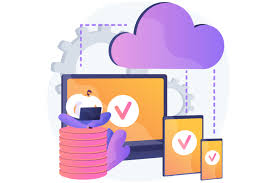The Software as a Service (SaaS) model has revolutionized how businesses deliver and consume software. As organizations increasingly adopt SaaS solutions, understanding the SaaS product lifecycle becomes crucial for developers and entrepreneurs. This article will explore the various stages of the SaaS product lifecycle, highlighting best practices for successful planning, development, and launch.
Understanding the SaaS Product Lifecycle
The SaaS product lifecycle encompasses several stages, from initial concept to market launch and ongoing maintenance. Each phase requires careful planning, execution, and evaluation to ensure the product meets market needs and achieves business goals. Here are the key stages:
1. Ideation and Planning
The first step in the saas development life cycle is ideation. This stage involves brainstorming ideas and identifying potential solutions to specific problems. Key activities during this phase include:
- Market Research: Understanding target customers, their pain points, and existing solutions in the market.
- Competitive Analysis: Analyzing competitors to identify gaps in their offerings and opportunities for differentiation.
- Defining the Value Proposition: Articulating the unique benefits your SaaS product will deliver to customers.
Once the concept is validated, a detailed project plan is created. This plan outlines the product vision, target audience, features, and success metrics.
2. Product Design
The design phase focuses on creating a user-centered experience that aligns with the needs identified during the planning stage. Key components include:
- Wireframes and Prototypes: Developing low-fidelity wireframes and interactive prototypes to visualize the product layout and user flow.
- User Experience (UX) Design: Prioritizing intuitive navigation, accessibility, and usability to enhance customer satisfaction.
- User Interface (UI) Design: Creating visually appealing designs that reflect the brand and facilitate engagement.
3. Development
Once the design is finalized, the development phase begins. This is where the actual coding and implementation of the SaaS application take place. Key practices include:
- Agile Development: Implementing Agile methodologies enables iterative development, allowing teams to release features incrementally. Agile practices foster collaboration, adaptability, and responsiveness to changes.
- Version Control: Using tools like Git ensures that code is managed effectively, enabling multiple developers to collaborate without conflicts.
- Continuous Integration and Continuous Deployment (CI/CD): Automating the integration and deployment processes ensures that new features can be released quickly and reliably.
4. Testing and Quality Assurance
Before launching the product, thorough testing is crucial to ensure functionality, performance, and security. This phase includes:
- Functional Testing: Verifying that the software performs as expected and meets the defined requirements.
- Performance Testing: Assessing how the application performs under various conditions, including load testing and stress testing.
- Security Testing: Identifying vulnerabilities to safeguard user data and maintain compliance with regulations such as GDPR and CCPA.
Read More: Building the Future of Manufacturing Industries with Innovative App Solutions
5. Launch
The launch phase is critical for introducing the SaaS product to the market. Key steps include:
- Marketing Strategy: Developing a go-to-market strategy that includes branding, messaging, and promotional activities to create awareness and attract users.
- Onboarding Process: Designing an effective onboarding experience to help new users understand the product’s features and benefits. This could include tutorials, walkthroughs, and customer support resources.
- Feedback Loop: Establishing channels for user feedback allows the team to gather insights and make necessary adjustments post-launch.
6. Post-Launch Evaluation and Iteration
After the product launch, continuous improvement is essential for long-term success. This phase includes:
- User Analytics: Monitoring user behavior and engagement through analytics tools to identify areas for improvement.
- Feature Requests: Listening to customer feedback to prioritize new features and enhancements that meet user needs.
- Regular Updates: Implementing a schedule for regular updates and maintenance to ensure the software remains secure and relevant.
7. Scaling
As your SaaS product gains traction, scaling becomes a priority. This involves expanding your infrastructure, optimizing performance, and enhancing user support. Key considerations include:
- Infrastructure Management: Utilizing cloud services like AWS, Google Cloud, or Azure to scale resources based on demand, ensuring reliability and performance.
- User Support Systems: Implementing support channels such as chatbots, help centers, and dedicated customer support teams to assist users effectively.
- Marketing Expansion: Exploring new market segments and geographic regions to increase your user base.
Best Practices for Successful SaaS Product Development
- Customer-Centric Approach: Continuously engage with users throughout the lifecycle to ensure that the product aligns with their needs and preferences. Use surveys, interviews, and usability testing to gather valuable insights.
- Embrace Agile Methodologies: Adopting Agile practices allows teams to remain flexible and responsive to changing market demands. Regular iterations and feedback loops ensure continuous improvement.
- Invest in Security: Prioritize security from the outset. Implement best practices such as encryption, regular security audits, and compliance with data protection regulations to build trust with users.
- Leverage Cloud Solutions: Utilize cloud platforms for development and deployment to benefit from scalability, flexibility, and cost-effectiveness. Cloud-based solutions can simplify infrastructure management and enhance collaboration.
- Monitor Metrics: Establish key performance indicators (KPIs) to track the success of your SaaS product. Metrics such as customer acquisition cost (CAC), lifetime value (LTV), churn rate, and user engagement will help guide decision-making.
Conclusion
The SaaS product lifecycle is a dynamic process that requires careful planning, execution, and ongoing evaluation. By understanding each stage, from ideation to scaling, organizations can optimize resource management, enhance customer satisfaction, and drive long-term success.
Implementing Agile practices, focusing on user experience, and leveraging cloud solutions are key strategies that can significantly impact the effectiveness of SaaS application development. As the SaaS landscape continues to evolve, staying attuned to user needs and market trends will be critical for maintaining a competitive edge. Through diligent attention to the product lifecycle, companies can navigate the complexities of SaaS development and achieve successful launches that resonate with users.

